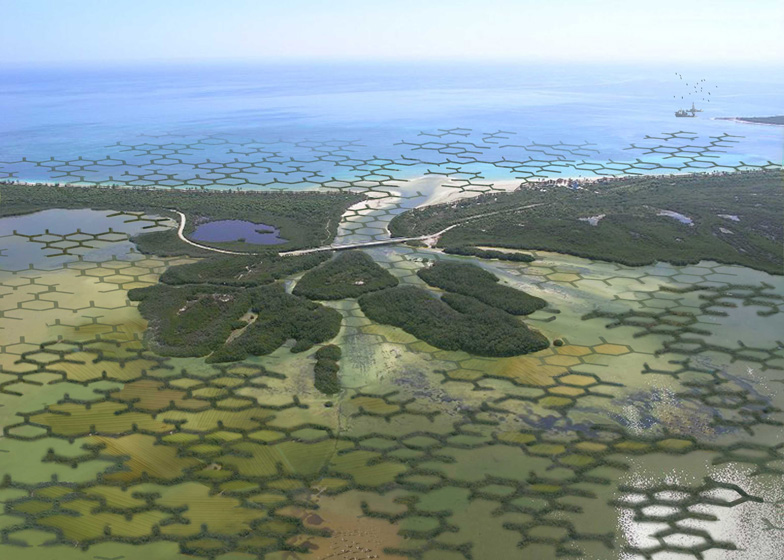Hungarian art and design collective Szövetség'39 has unveiled a concept to reduce the impact of rising sea levels in the world's delta regions by introducing a modular structure that will cultivate mangrove forests to form natural dams.
Anna Baróthy of Szövetség'39 worked in a design team that included biologist and diver Gergő Balázs, designer Janka Csernák and scientist Viktor Grónás to develop the CALTROPe concept, which seeks to prevent the loss of agricultural land caused when pollution and climate change provoke water levels to rise.
After carefully studying the biological qualities of mangroves, the designers found that the salt-tolerant plants act as a natural breakwater against tides, trapping river sediment in their strong roots and helping to prevent ecosystems from washing away.
"After having examined the processes of sedimentation, the hydrodynamic characteristics, and the ecological conditions, we concluded that the intentional retention of water-borne alluvium carried in big qualities by the delta rivers could be the key to compensate land loss caused by sea level rise," explain the team in their design report.
The designers propose an structure that can be easily installed beneath the water's surface, providing a modular infrastructure to house growing mangrove plants, which thrive in coastal habitats.
"The modules serve as containers and incubators for the young mangrove saplings that, getting stronger with time, will become self-supporting and form a natural dam," said theteam.
The project is named CALTROPe - a mixture of the words caltrop (a kind of water chestnut) and rope. The first is a reference to the the curving shape of the objects, while the second refers to the lacy appearance of the modules when combined.
Made from a combination of concrete and organic materials, the structures are expected to crumble away after 15 to 20 years. By this point the plants will be strong enough to support themselves and the dissolved material will become part of the sediment.
"We believe that, when the sea level will go beyond a critical point, the quantity of sediment trapped will form sufficiently high dams to save the current lands," said the designers. "The protected areas can also be used agriculturally or can be populated because their soil is rich in nutrients and they are solid enough."
Another benefit of the structure is that it will create new habitats for oysters and prawns.
The project was recently named one of three overall winners in a design competition launched by the Jacques Rougerie Foundation, a non-profit organisation focussing on the relationship between architecture and the sea.
Here's a project description from Szövetség'39:
CALTROPe: Grand Prix winner Hungarian architecture project in Paris
The Budapest-based Szövetség'39 creative team has won the Grand Prix in the category 'Architecture and sea level rise' awarded by the International Architecture Competition organised by the Jacques Rougerie Foundation. The young Hungarian designers' project called CALTROPe answered the challenge caused by loss of territory due to the water level rise in an innovative and sustainable manner.
The aim of the project is to synthesise and balance the natural dynamics and forces of the delta regions applying an easy-to-install modular structure. CALTROPe is a lace-like structure that is able to catch and collect river sediment with the help of mangrove plants, so integrating natural and architectural elements. Working like a catalyst, it will provoke positive changes at the most critical shoreline points. With this cooperative, participatory and locally supplied work can also reorganise and socialise the local population in a constructive and self-supporting manner.
CALTROPe comes from the words 'caltrop' (water chestnut) and 'rope', 'caltrop' referring to the shape of the object, and 'rope', to the linear, lace-like installation principles.
The concept of CALTROPe has been set up by Szövetség'39 Art Base that focuses usually on especially complex artistic planning. In this case the members of the team were Anna Baróthy, leading designer and project manager of Szövetség'39, Gergő Balázs biologist and diver, Janka Csernák designer, Dr. Viktor Grónás senior lecturer of the Szent István University's Nature Conservation and Ecology Department, diver, Peter Kovacsics graphic and animation designer, Viktor Pucsek and Peter Vető industrial and 3D designers. The project staff was Melinda Bozsó, designer of Szövetség'39, Daniel Csomor architect, Kata Kerekes graphic designer, Vera Krauth architecture student, Ábel Kurta and Veronika Szabó product design students and Nóra Lajkó student in fine arts and painting.
This spring the Jacques Rougerie Foundation announced an international architectural competition in three categories. The call for a total of 529 entries were submitted from 76 countries of the world, out of which CALTROPe won the grand-prix. The competition is named after Jacques Rougerie who is one of the world's most innovative visionary architects. Rougerie is an expert in space and underwater structures – he has designed the soon-to-be first underwater museum in Egypt and the SeaOrbiter that is a cross between a skyscraper and a boat for exploring the unchartered territories of the earth's oceans.
Szövetség '39 is an association of artists who primarily deals with complex artistic design. The subject matter of design typically related to some form of spatial situations, such as installations, artistic design of buildings, actions and artworks of plazas, public spaces. The current members of the group are: Anna Baróthy, Csenge Kolozsvári and Melinda Bozsó joined by artists and creative groups in the workshop as well. Szövetség '39 is an open workshop-site and assures an open-mind, recipient ambient for the development of tentative concepts. Just as the Szövetség '39 conveys new-thinking and innovative ideas through hosting related events, actions regularly in the workshop. The main profiles of the present members are: architecture, media-art, computer graphics, web design, experimental programming, animation and design of glass.

